When we first sat down to plan the fashion issue, we reflected on our experiences as Georgetown students. At first, we thought of our daily routines as a masquerade ball, a celebration that descends from the Catholic tradition in Venice. Hiding behind masks, people do what they otherwise wouldn’t before the paucity of Lent arrives. This is not so different from how we live as Georgetown students—whether it’s going to class in business casual before an interview or donning a tuxedo for Senior Ball.
Clearly, though, these masks run deeper than just Georgetown’s Catholic faith. They can be homemade and cultural too, so we extended the theme to reflect that. Though masks can protect us from being seen, in the design of the shield they reveal who we are. But sometimes they can be costly. On the one hand, the clothes we brought in were worth more than our savings. On the other hand, wearing the clothes you are expected to can come at the cost of the clothes that make you feel like yourself.
Georgetown’s complicated history can pressure some students to raise their guard. Dressing the part of a student at Georgetown is complicated when people that look like you were sold to pay its debt, or when students and faculty alike stumble over your pronouns because of how you look.
Catholic Prep is the imaginary setting for our photoshoot. Catholic Prep stands for the generic high school that curates Georgetown students’ style before they arrive on campus, concentrated in the hands of a class of young, white people, and for the way Georgetown prepares us to become young professionals in the way we conduct ourselves. Separately, Catholic and Prep are the two trends we wanted to respond to in our images. At Catholic Prep, kids wear suits. No one bats an eye when you take your headshot in front of Dahlgren Chapel.
These are the themes we hoped to reckon with in our photoshoot, Masquerade: Catholic Prep. In the written content, Voice staffers explored the history of dress codes at Georgetown (page 6), the realities of clothing insecurity for D.C. residents (page 14), and the ways in which high and personal fashion affect their everyday expressions of self (page 4-5).
The stress of wearing these masks can suffocate us, but they can also be beautiful, something we hoped to reveal in this issue. Welcome to the masquerade ball.
Much love,
Max + Kayla





